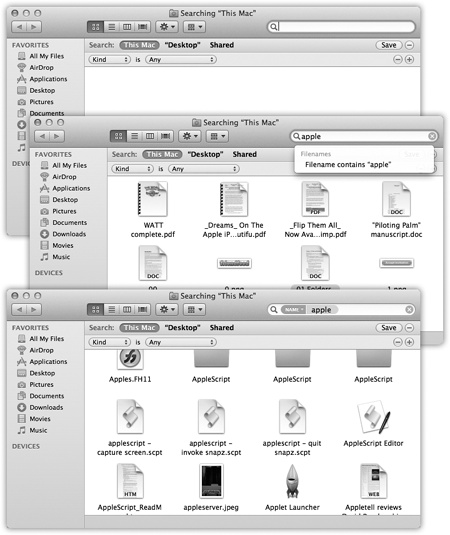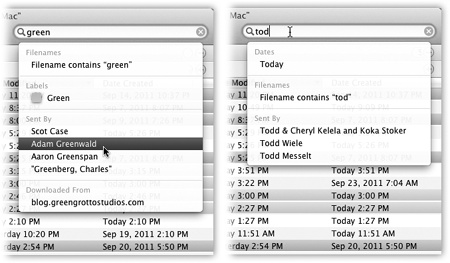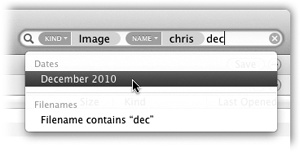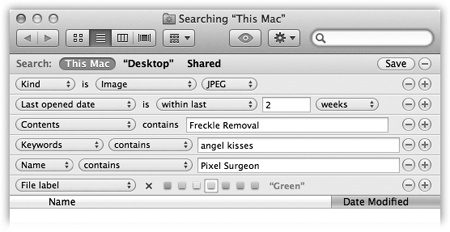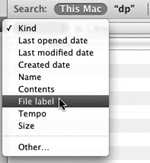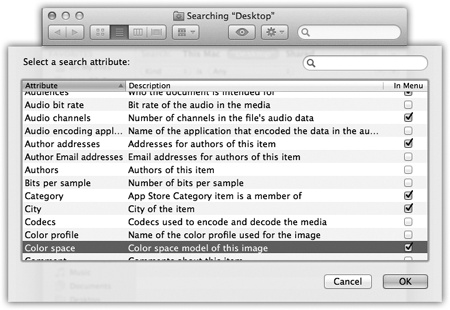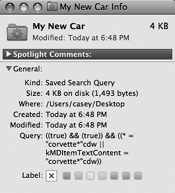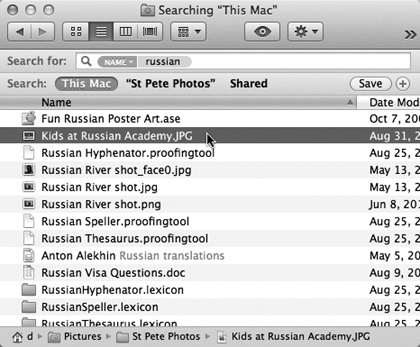As you may have noticed, the Spotlight menu doesn’t list every match on your hard drive. Unless you own one of those extremely rare 60-inch Apple Skyscraper Displays, there just isn’t room.
Instead, Spotlight uses some fancy behind-the-scenes analysis to calculate and display the 20 most likely matches for what you typed. But at the top of the menu, you usually see that there are many other possible matches; it says, “Show All in Finder,” meaning that there are other candidates. (Mac OS X no longer tells you how many other results there are.)
There is, however, a second, more powerful way into the Spotlight labyrinth. And that’s to use the Spotlight window, shown in Figure 3-3. It’s had an extreme makeover in Lion.
You can open the Spotlight window in either of two ways:
If the Spotlight menu—its Most Likely to Succeed list—doesn’t include what you’re looking for, then click Show All in Finder. You’ve just opened the Spotlight window.
Now you have access to the complete list of matches, neatly listed in what appears to be a standard Finder window.
When you’re in the Finder, you can also open the Spotlight window directly, without using the Spotlight menu as a trigger. Actually, there are three ways to get there:
⌘-F (for Find, get it?). When you choose File→Find (⌘-F), you get an empty Spotlight window, ready to fill in for your search (Figure 3-3, top).
Tip
When the Find window opens, what folder does it intend to search?
That’s up to you. Choose Finder→Preferences→Advanced. From the “When performing a search” pop-up menu, you can choose Search This Mac, Search the Current Folder (usually what you want), or Use the Previous Search Scope (that is, either “the whole Mac” or “the current folder,” whichever you set up last time).
Option⌘-space bar. This keystroke opens the same window. But it always comes set to search everything on your Mac (except other people’s Home folders, of course), regardless of the setting you made in Preferences (as described in the Tip above).
Open any desktop window, and type something into the Search box at upper right. Presto—the mild-mannered folder window turns into the Spotlight window, complete with search results.
Tip
You can change the Find keystrokes to just about anything you like. See Privacy Settings.
When the Searching window opens, you can start typing whatever you’re looking for into the Search box at the top.
As you type, the window fills with a list of the files and folders whose names contain what you typed. It’s just like the Spotlight menu, but without the 20-item limit (Figure 3-3, middle).
Figure 3-3. Top: The Spotlight window stands ready to search the currently open window. Middle: When you begin to type your search term, Lion presents a pop-up menu of suggestions. For example, when you type apple, it’s asking: “Would you like me to limit the search results to files with the word ‘apple’ in their names?” If you ignore the suggestions, the window shows you all matches—including files with the word “apple” inside them. Bottom: But if you click one of those suggestions—“Filename contains apple,” in this case—the results window changes. Now you’re seeing only icons that contain the word “apple.”
The three phrases at the top of the window—This Mac, [Folder Name], and Shared—are buttons. Click one to tell Spotlight where to search:
This Mac means your entire computer, including secondary disks attached to it (or installed inside)—minus other people’s files, of course.
“Letters to Congress” (or whatever the current window is) limits the search to whatever window was open. So if you want to search your Pictures folder, open it first and then hit ⌘-F. You’ll see the Pictures button at the top of the window, and you can click it to restrict the search to that folder.
Shared. Click this button to expand the search to your entire network and all the computers on it. (This assumes, of course, that you’ve brought their icons to your screen as described in Chapter 13.)
If the other computers are Macs running Leopard, Snow Leopard, or Lion, Spotlight can search their files just the way it does on your own Mac—finding words inside the files, for example. If they’re any other kind of computer, Spotlight can search for files only by name.
Tip
If the object of your quest doesn’t show up, you can adjust the scope of the search with one quick click on another button at the top of the window, like This Mac or Shared. Spotlight updates the results list.
Then again, if you always prefer one of those options, don’t forget that you can save yourself a click by choosing it to be the new factory setting. Specify your favorite “where to look” option by visiting Finder→Preferences→Advanced and using the “When performing a search” pop-up menu. Your choices are Search This Mac, Search the Current Folder, or Use the Previous Search Scope (that is, “whatever I chose last time”).
Until Lion came along, the Find window offered two other important buttons at the top: Contents, meaning, “Search for the words inside your files, along with all the metadata attached to them,” and File Name, for when it’s faster to search for characters in the file’s name, just as people did before Spotlight came along.
In Lion, those buttons are gone. Instead, Mac OS X tries to figure out what you’re looking for—file names or words inside files. It may show you both in the same results list.
But more important, it offers a new suggestions pop-up menu, shown in Figure 3-4. Its purpose is to help you narrow down the results list with one quick click. Whatever you click here is instantly immortalized as a search token, described below.
You may see any of these headings in the suggestions list:
Filenames. The top option is always “Filenames”; click it to search by the files’ names only. If you type chris into the box, you want files whose names contain that word.
Sent by. If you type chris, the Mac wants to know if, by chance, you’re looking for email messages and other documents from somebody named Chris (or Christina, or Christopher…).
Kinds. If you type image, the Kinds option here offers you choices like image (any kind), JPEG image, Disk image, or Portable Network Graphics Image. If you type document, you get options like Word document and PDF document. If you search for photo, the menu lets you pinpoint files whose file type contains “photo”—like iPhoto Libraries or Adobe Photoshop files. And so on.
Downloaded From. You see this option when what you type is a Web address. If you type Macworld into the Search box, then “Downloaded From Macworld.com” appears in the results list—a handy way to round up all the files you’ve downloaded from a specific site.
Dates. If you type a month (august, aug, or august 2012) or a year into the search box, the suggestions pop-up menu says, “Dates: August 2012” (or whatever). Clicking it lets you do a quick roundup of all files you created, modified, last opened, or added during that period.
Labels. Here’s yet another way to use the file labels described on Color Labels. When you type a search term that matches one of your labels (for example, green), the suggestions menu includes “Labels: green.”
In each case, the suggestions in this menu reflect only files that actually exist on your Mac. If you search for “green,” but green isn’t one of your Finder labels, then the Labels suggestion doesn’t appear. If you haven’t downloaded anything from Macworld.com, then that option doesn’t appear. And so on.
Once you learn to actually start using these suggestions—once you get a hang of the kinds of things they offer—you can get a lot of mileage out of them.
If, on the other hand, you just find them confusing, no big deal. Tap the Esc key to close the suggestions list and reveal the existing Searching window.
The real beauty of the Searching window is that it can hunt down icons via more specific searches than you could do using the Spotlight menu. For example, a new Lion feature called tokens let you combine criteria, so you find only music files sent to you by Casey. (A token, in Apple’s usage, means “a visual representation of a search criterion.”)
Here, for example, is how you might search for pictures of Chris that were last opened in December.
In the Finder, press ⌘-F.
In the Search box, type image.
Sure enough: The window now shows everything on your Mac that is an image or contains the word “image” in its name, or even contains the word “image” within the file. But the list of suggestions (Figure 3-4) wants to know: which do you really want? Files that are images? Or files with the word “image” in their names?
In the suggestions menu, under Kinds, click Image.
You’ve just pared down the list of results. Now it shows only the files that are photos.
Note, too, that the first token has appeared. Each time you click a refinement criterion, as you did in this step, Mac OS X enshrines it in the Search box as a shaded bubble. In this case, it created a token that says “Kind: Image.” (You can see it in Figure 3-5.)
Note
See the tiny
 next to the search token’s name? You
can click it to see a very short pop-up menu of options: the
criterion you selected (like “Kind:” or “Date:”), and another
command that says “Everything.” Choosing it undoes the
filtering effect of the suggestion, so that this token
searches for any attribute of your file
(like the words inside it).
next to the search token’s name? You
can click it to see a very short pop-up menu of options: the
criterion you selected (like “Kind:” or “Date:”), and another
command that says “Everything.” Choosing it undoes the
filtering effect of the suggestion, so that this token
searches for any attribute of your file
(like the words inside it).Why do you need an “Everything” option here? If you’d wanted to search all attributes on your Mac, you could have just typed directly into the Search box without even using the suggestions menu.
Three reasons. First, you might want to expand the scope (from Kind to “Everything,” for example) without having to retype the search term. Second, because you might want to make this token part of a smart folder—a saved search—described at the end of this chapter. Finally, you might want to go on to add another search criterion—another search token—that builds on this search for “Everything.”
Now you need to narrow the quest to files containing the word Chris.
Continue typing in the Search box. This time, type chris.
The suggestions appear again, offering options for file names and, probably, a Sent By list that lists everyone named Chris who’s ever sent you messages or files. What you want is images whose names contain the word “Chris.”
Click Filename.
The list of files is much smaller now. It shows only image files with “Chris” in their names.
For your final stunt, you’ll screen out all but the December images.
Continue typing in the Search box. This time, type dec.
This time, the suggestions list offers dates like December 2010 and December 2011. You can see the result so far in Figure 3-5.
Click the month you want.
And voilà: The results list shows you only the December photos of Chris.
To delete a token, click it and then press the Delete key, or backspace over it. You can also edit one: Double-click the right side of the token bubble; now you can retype the search term.
Lion’s search tokens are supposed to make multi-criteria searches easier than they used to be. But they’re not as powerful as the Old Way, which is still around.
Using the Old Way of power searching, you can set up a search that finds a document whose name begins with the letters Cro, is over a megabyte in size, was created after 10/1/11 but before the end of the year, was changed within the past week, has the file name suffix .doc, and contains the phrase “attitude adjustment.” (Of course, if you knew that much about a file, you’d probably know where it is, too. But you get the picture.)
In all, the Old Way lets you specify over 125 different search criteria: date modified, file size, the “last opened” date, color label, copyright holder’s name, shutter speed (of a digital photo), tempo (of a music file), and so on. Figure 3-6 illustrates how detailed this kind of search can be.
To set up a complex search like this, use the second row of controls at the top of the window.
And third, and fourth, and fifth. Each time you click one of
the ![]() buttons at the right end of the window, a new
criterion row appears; use its pop-up menus to specify
what date, what file size,
and so on.
buttons at the right end of the window, a new
criterion row appears; use its pop-up menus to specify
what date, what file size,
and so on.
Tip
If you press Option, the ![]() button changes into a “…” button. When you
click it, you get sub-rows of parameters for a single criterion. A
pop-up menu lets you choose Any, All, or None, so that you can
build what are called exclusionary searches.
button changes into a “…” button. When you
click it, you get sub-rows of parameters for a single criterion. A
pop-up menu lets you choose Any, All, or None, so that you can
build what are called exclusionary searches.
The idea here is that you can set up a search for documents created between November 1 and 7 or documents created between November 10 and 14. Or files named Complaint that are also either Word or InDesign files.
The mind boggles.
Figure 3-6. By repeatedly clicking the ![]() button, you can turn on as many criteria as
you’d like; each additional row further narrows the search. To
delete a row, click the
button, you can turn on as many criteria as
you’d like; each additional row further narrows the search. To
delete a row, click the ![]() button at its right end.
button at its right end.
Here’s a rundown of the ways you can restrict your search, according to the options in the first pop-up menu of a row. Note that after you choose from that first pop-up menu (Last Opened, for example), you’re supposed to use the additional pop-up menus to narrow the choice (“within last,” “2,” and “weeks,” for example), as you’ll read below.
Note
It may surprise you that choosing something from the Kind pop-up menu triggers the search instantly. As soon as you choose Applications, for example, the window fills with a list of every program on your hard drive. Want a quick list of every folder on your entire machine? Choose Folders. (Want to see which folders you’ve opened in the past couple of days? Add another row.)
If you also type something into the Search box at the very top of the window—before or after you’ve used one of these pop-up menus—the list pares itself down to items that match what you’ve typed.
When the first pop-up menu says Kind, you can use the second pop-up menu to indicate what kind of file you’re looking for: Applications, Documents, Executables (programs and Dashboard widgets), Folders, Images, Movies, Music, PDF files, Presentations, Text files, or Other.
For example, when you’re trying to free up some space on your drive, you could round up all your movie files, which tend to be huge. Choosing one of these file types makes the window begin to fill with matches automatically and instantly.
And what if the item you’re looking for isn’t among those 10 canned choices? What if it’s an alias, or a Photoshop plug-in, or some other type?
That’s what the Other option is all about. Here you can type in almost anything that specifies a kind of file: Word, Excel, TIFF, JPEG, AAC, final cut, imovie, alias, zip, html, or whatever.
When you choose one of these options from the first pop-up menu, the second pop-up menu lets you isolate files, programs, and folders according to the last time you opened them, the last time you changed them, or when they were created.
Today, yesterday, this week, this month, this year. This second pop-up menu offers quick, canned time-limiting options.
Within last, exactly, before, after. These let you be more precise. If you choose “before,” “after,” or “exactly,” then your criterion row sprouts a month/day/year control that lets you round up items that you last opened or changed before, after, or on a specific day, like 5/27/12. If you choose “within last,” then you can limit the search to things you’ve opened or changed within a specified number of days, weeks, months, or years.
These are awesomely useful controls, because they let you specify a chronological window for whatever you’re looking for.
Tip
You’re allowed to add two Date rows—a great trick that lets you round up files that you created or edited between two dates. Set up the first Date row to say “is after” and the second one to say “is before.”
In fact, if it doesn’t hurt your brain to think about it, how about this? You can even have more than two Date rows. Use one pair to specify a range of dates for the file’s creation date and two other rows to limit when it was modified.
Science!
Spotlight likes to find text anywhere inside your files, no matter what their names are. But when you want to search for an icon by the text that’s in only its name, this is your ticket. (Capitalization doesn’t matter.)
Wouldn’t it be faster just to click Filename in the suggestions pop-up menu (Figure 3-4)? Yes—but using the Search window offers you far more control, thanks to the second pop-up menu that offers you these options:
Matches. You’ll see files whose names contain entire words you’re looking for. For example, if you search for peas, you’ll find files called “Peas & Crackers” and “Snow Peas”—but not “Appeasement.”
Contains. The position of the letters you type doesn’t matter. If you type then, you find files with names like “Then and Now,” “Authentic Cajun Recipes,” and “Lovable Heathen.”
Starts with. The Find program finds only files beginning with the letters you type. If you type then, you find “Then and Now,” but not “Authentic Cajun Recipes” or “Lovable Heathen.”
Ends with. If you type then, you find “Lovable Heathen,” but not files called “Then and Now” or “Authentic Cajun Recipes.”
Is. This option finds only files named precisely what you type (except that capitalization still doesn’t matter). Typing then won’t find any of the file names in the previous examples. It would unearth only a file called simply “Then.” In fact, a file with a file name suffix, like “Then.doc,” doesn’t even qualify.
(If this happens to you, though, here’s a workaround: From the first pop-up menu, choose Other; in the dialog box, pick Filename. The Filename criterion ignores extensions; it would find “Then.doc” even if you searched for “then.”)
You can think of this option as the opposite of Name. It finds only the text that’s inside your files, and completely ignores their icon names.
That’s a handy function when, for example, a document’s name doesn’t match its contents. Maybe a marauding toddler playing Kid Pix renamed your doctoral thesis “xggrjpO#$5%////.” Or maybe you just can’t remember what you called something.
If this were a math equation, it might look like this: options x options = overwhelming.
Choosing Other from the first pop-up menu opens a special dialog box containing at least 125 other criteria. Not just the big kahunas like Name, Size, and Kind, but far more targeted (and obscure) criteria like “Bits per sample” (so you can round up MP3 music files of a certain quality), “Device make” (so you can round up all digital photos taken with, say, a Canon Rebel camera), “Key signature” (so you can find all the GarageBand songs you wrote in the key of F sharp), “Pages” (so you can find all Word documents that are really long), and so on. As you can see in Figure 3-7, each one comes with a short description.
Figure 3-7. Here’s the master list of search criteria. Turn on the In Menu checkboxes of the ones you’ll want to reuse often, as described in the box on the facing page. Once you’ve added some of these search criteria to the menu, you’ll get an appropriate set of “find what?” controls (“Greater than” and “Less than” pop-up menus, for example).
You may think Spotlight is offering you a staggering array of file-type criteria. In fact, though, big bunches of information categories (technically called metadata) are all hooks for a relatively small number of document types. For example:
Digital photos and other graphics files account for the metadata types alpha channel, aperture, color space, device make, device model, EXIF version, exposure mode, exposure program, exposure time, flash, f-number, focal length, ISO speed, max aperture, metering mode, orientation, pixel height, pixel width, red eye, resolution height, resolution width, and white balance.
Digital music files have searchable metadata categories like album, audio bit rate, bits per sample, channel count, composer, duration, General MIDI sequence, key signature, lyricist, musical genre, recording date, sample rate, tempo, time signature, track number, and year recorded. There’s even a special set of parameters for GarageBand and Soundtrack documents, including instrument category, instrument name, loop descriptors, loop file type, loop original key, and loop scale type.
Microsoft Office documents can contain info bits like authors, contributors, fonts, languages, pages, publishers, and contact information (name, phone number, and so on).
This massive list also harbors a few criteria you may use more often, like Size, File Label, and Visibility (which lets you see all the invisible files on your hard drive). See the box on Feeding the Barren Pop-up Menus.
Now, you could argue that in the time it takes you to set up a search for such a specific kind of data, you could have just rooted through your files and found what you wanted manually. But hey—you never know. Someday, you may remember nothing about a photo you’re looking for except that you used the flash and an f-stop of 1.8.
Tip
Don’t miss the Search box in this dialog box. It makes it super-easy to pluck one useful criterion needle—Size, say—out of the haystack. Also don’t forget about the In Menu checkbox in the right column. It lets you add one of these criteria to the main pop-up menu, so you don’t have to go burrowing into Other again the next time.
The results window is a regular old Finder window, with all the familiar views and controls (Figure 3-8).
You can work with anything in the results window exactly as though it were in a regular Finder window: Drag something to the Trash, rename something, press the space bar for a Quick Look at it, drag something to the desktop to move it there, drag something onto a Dock icon to open it with a certain program, Option-⌘-drag it to the desktop to create an alias, and so on.
You can move up or down the list by pressing the arrow keys, scroll a “page” at a time with the Page Up and Page Down keys, and so on. You can also highlight multiple icons simultaneously, the same way you would in a Finder list view: Highlight all of them by choosing Edit→Select All, highlight individual items by ⌘-clicking them, drag diagonally to enclose a cluster of found items, and so on.
Or you can proceed in any of these ways:
Change the view (list, column, etc.) by clicking one of the View icons or choosing from the View menu (see Chapter 1). Actually, Cover Flow is a great view for search results; since this list is culled from folders all over the computer, you otherwise have very little sense of context as you examine the file names.
Sort the results by clicking the column headings (in list and Cover Flow views).
Arrange the results by using Lion’s new Arrange pop-up menu button (
 ). That way, you group the results as
described on Use as Defaults. It can be
especially useful to clump them by Kind, so that similar file
types are clustered together (Documents, Images, Messages, and
so on), or to sort by Last Opened, so that the list is
chronological.
). That way, you group the results as
described on Use as Defaults. It can be
especially useful to clump them by Kind, so that similar file
types are clustered together (Documents, Images, Messages, and
so on), or to sort by Last Opened, so that the list is
chronological.Figure 3-8. Click a result once to see where it sits on your hard drive (bottom). If the window is too narrow to reveal the full folder path, run your cursor over the folders without clicking. As your mouse moves from one folder to another, the Mac briefly reveals its name, compressing other folders as necessary to make room. (Sub-Tip: You can drag icons into these folders, too.)
Change the view options. Press ⌘-J (or choose View→Show View Options) to open the View Options panel for the results window. Here you can add a couple of additional columns (Date Modified, Date Created); change the icon size or text size; or turn on the “always” checkbox at the top, so that future results windows will have the look you’ve set up here.
Get more information about a result by selecting it and then choosing File→Get Info (⌘-I). The normal Get Info window appears, complete with date, size, and location information.
Find out where it is. It’s nice to see all the search results in one list, but you’re not actually seeing them in their native habitats: the Finder folder windows where they physically reside.
If you click once on an icon in the results, the bottom edge of the window becomes a folder map that shows you where that item is.
For example, in Figure 3-8, the notation in the Path strip means: “The Kids at Russian Academy.JPG icon you found is in the St. Pete Photos folder, which is in the Pictures folder, which is in d’s Home folder.”
To get your hands on the actual icon, choose File→Open Enclosing Folder (⌘-R). Mac OS X highlights the icon in question, sitting there in its window wherever it happens to be on your hard drive.
Open the file (or open one of the folders it’s in). If one of the found files is the one you were looking for, double-click it to open it (or highlight it and press either ⌘-O or ⌘-↓). In many cases, you don’t know or care where the file was—you just want to get into it.
Tip
You can also double-click to open any of the folders in the folder map at the bottom of the window. For example, in Figure 3-8, you could double-click the selected JPEG icon to open it, or the St Pete Photos folder to open it, and so on.
Move or delete the file. You can drag an item directly out of the found-files list and into a different folder, window, or disk—or straight to the Dock or the Trash. If you click something else and then re-click the dragged item in the results list, the folder map at the bottom of the window updates itself to reflect the file’s new location.
Start over. If you’d like to repeat the search using a different search phrase, just edit the text in the Search box. (Press ⌘-F to empty the Search box and the Spotlight window.)
Give up. If none of these avenues suits your fancy, you can close the window as you would any other (⌘-W).
Get Mac OS X Lion: The Missing Manual now with the O’Reilly learning platform.
O’Reilly members experience books, live events, courses curated by job role, and more from O’Reilly and nearly 200 top publishers.
